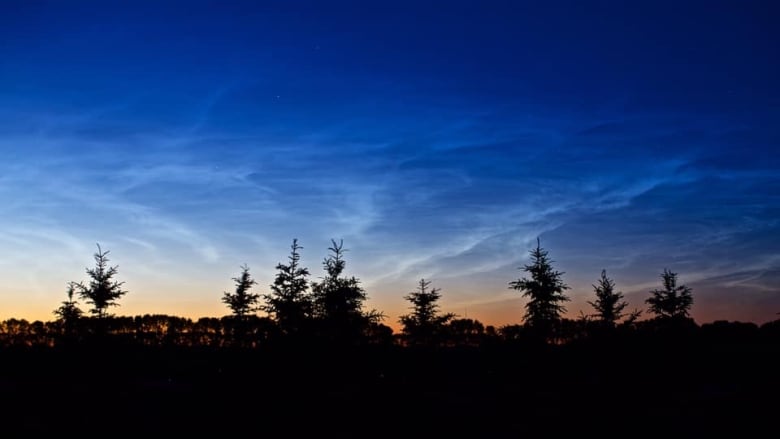It's that time of year again, when skywatchers get the chance to see a rare, shimmering type of cloud in the evening sky.
Noctilucent clouds (NLCs), or polar mesospheric clouds, are breathtaking to see. And these are no ordinary clouds. They form in the highest part of our atmosphere, at an altitude of 80 kilometres.
NLCs aren't all that well understood. However, researchers believe they're caused by meteor dust in our upper atmosphere.
They're most prominent in the Northern Hemisphere from roughly June to July (although they can occur from May to August) and need three things to be present: an increase in water vapour, very cold temperatures and particles on which the water vapour can freeze, such as leftover dust from meteors (and sometimes by particles left over from rocket launches).
As well, the sun needs to be at least six degrees below the horizon to illuminate the clouds.
These clouds used to be relegated to the extreme northern latitudes (or southern in the summer months), but over the past decade they seem to be moving south. In 2019, they were seen as far south as California.

A 2018 study suggested they may be moving farther south due to climate change. While NLCs were likely visible for centuries, the authors claim, they were far too faint to see with the naked eye. But as Earth warmed, there was more water vapour present in the atmosphere, allowing them to become brighter. And now with climate change, there's even more water vapour present, particularly at lower latitudes.
Did you miss the noctilucent show over <a href="https://twitter.com/hashtag/yyc?src=hash&ref_src=twsrc%5Etfw">#yyc</a> last night? Since it doesn't seem like they're back tonight, here's a timelapse of about 30 minutes of the show in 20 seconds. The video is looped 3 times so you can watch the delicate movements to your heart's content. <a href="https://twitter.com/PrairieChasers?ref_src=twsrc%5Etfw">@PrairieChasers</a> <a href="https://t.co/tOKzdD2EdU">pic.twitter.com/tOKzdD2EdU</a>
—@adolwynAnother contributing factor may be the sun. The sun goes through an 11-year cycle, with solar activity — such as sunspots — waxing and waning. The past few cycles, however, have been less active than in the past. When the sun isn't as active, our mesosphere cools down. With increased water vapour and the cooling of the mesosphere, it may make conditions just right for NLCs to form.
As to why they're blue, that's due to ozone. Sunlight that reaches the clouds first passes through the ozone layer, which absorbs red light but allows blue light to pass through.

Over the past week, many people from across the country have seen noctilucent clouds, with many in Alberta, Saskatchewan and Manitoba reporting the wispy clouds shimmering in the sky after sunset.
They've even been seen as far south as Oregon, Washington and Montana, as well as across parts of northern Europe.
But it's not just Earth that experiences NLCs. Just last month, NASA's Curiosity rover photographed the clouds on Mars.
If you'd like to see them for yourself, head out roughly 30 minutes after sunset or before sunrise and look toward the north. The lower your latitude — below 50 degrees north — the more likely they will appear on the horizon, so it's best if you can get somewhere with an unobstructed view. Sometimes NLCs can be confused with cirrus clouds that may be reflecting sunlight. The key difference is that NLCs are wispier and electric-blue.
https://news.google.com/__i/rss/rd/articles/CBMiSWh0dHBzOi8vd3d3LmNiYy5jYS9uZXdzL3NjaWVuY2Uvbm9jdGlsdWNlbnQtY2xvdWRzLW5vcnRoZXJuLXNreS0xLjYwNjk5NTnSASBodHRwczovL3d3dy5jYmMuY2EvYW1wLzEuNjA2OTk1OQ?oc=5
2021-06-19 08:00:00Z
CBMiSWh0dHBzOi8vd3d3LmNiYy5jYS9uZXdzL3NjaWVuY2Uvbm9jdGlsdWNlbnQtY2xvdWRzLW5vcnRoZXJuLXNreS0xLjYwNjk5NTnSASBodHRwczovL3d3dy5jYmMuY2EvYW1wLzEuNjA2OTk1OQ
Tidak ada komentar:
Posting Komentar